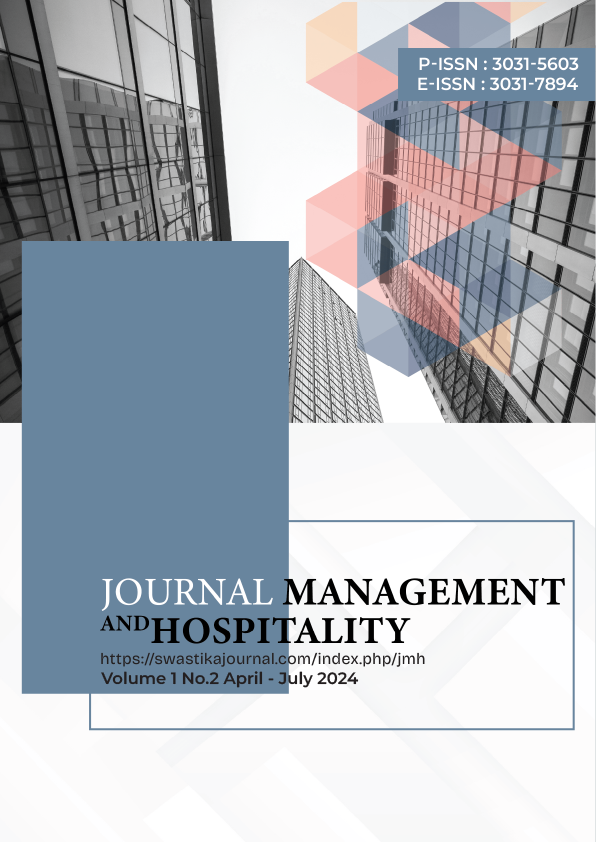Green Destinations as a Solution for Improving the Local Economy and Environmental Conservation
DOI:
https://doi.org/10.61857/jmh.v2i2.180Keywords:
Green Destination, Sustainable Tourism, Environmental Conservation, Local EconomyAbstract
The concept of green destination emerged as a solution to overcome the negative impact of tourism on the environment. This research analyzes the implementation of sustainable tourism through a literature study with a focus on four main pillars: carbon emission reduction, biodiversity preservation, sustainable waste management, and water resource conservation. The findings show that the success of a green destination depends on multi-stakeholder collaboration (government, local communities, industry, and tourists) and the implementation of strategies such as human resource capacity building, green policy incentives, and tourist education. Case studies from various regions in Indonesia such as Penglipuran Village, Komodo National Park, and Kampung Warna-Warni Jodipan prove that this approach can improve local economic welfare while preserving the environment. The main challenges faced are low environmental awareness and limited resources, but systematic solutions such as those outlined in this study can guide the development of sustainable tourism destinations in the future.
References
A.A. Putu Bayu Surya Dharma Gede, & Gede Yoga Kharisma Pradana2. (2022). Implikasi Penataan Desa Wisata Penglipuran terhadap Kelestarian Budaya Bali. Jurnal Pariwisata Indonesia, 18(1), 1–14. https://doi.org/10.53691/jpi.v18i1.269
Aisyah, L., & Febriana, S. (2020). Pemberdayaan masyarakat dalam pengembangan Kampung Warna-Warni Jodipan sebagai destinasi wisata kreatif. Jurnal Pengabdian Dan Pemberdayaan Masyarakat, 4(1), 45–52.
Aryana Sukma -, A., Konsep Wisata Desa Hijau, I., Studi Perencanaan Wilayah dan Kota Universitas Islam Sultan Agung Semarang Jl Kaligawe Raya No, P. K., Kulon, T., Genuk, K., Semarang, K., & Tengah, J. (2022). IMPLEMENTASI KONSEP DESA WISATA HIJAU Studi kasus : Dieng Plateu, Lombok Barat, Lombok Tengah. Jurnal Kajian Ruang, 2(2), 214–228. http://jurnal.unissula.ac.id/index.php/kr
Council, G. sustainable T. (2019). Kriteria Destinasi Global Suistanable Tourism Council. 0–17. https://www.gstcouncil.org/wp-content/uploads/GSTC-Destination-Criteria-v2.0-Bahasa-Indonesia.pdf
Dodds, R., & Joppe, M. (2001). A case study of sustainable tourism development in the Maldives. Current Issues in Tourism, 4(5), 416–435.
Fitriani, R., & Susilo, S. (2021). Pengembangan ekowisata mangrove Wonorejo Surabaya sebagai media edukasi lingkungan. Jurnal Kepariwisataan Indonesia, 15(2), 85–93.
Gibson, H., Kaplanidou, K., & Kang, S.-J. (2003). Urban green tourism: Travel experiences that inspire physically active and socially interactive experiences. Journal of Sport Tourism, 8(3), 324–333.
Harrison, D. (2001). Tourism and the Less Developed World: Issues and Case Studies. CABI Publishing.
Hidayat, R., Riza Mahendra, T., & Octavia, I. (2020). “Green Destination Tourism” Reviewed from Islamic Economic Perspective (Case Study in Pulesari Yogyakarta Tourist Village). Majalah Ilmiah Bijak, 17(2), 255–263. https://doi.org/10.31334/bijak.v17i2.730
I Made Widiantara, I Made Deddy Sandrawan, I. G. A. A. S. (2016). Green Ethic Behavior, Balinese Culture, and Green Marketing for Sustainable Tourism in Bali. 1–23.
Lee, W.-H., & Hsu, F.-M. (2011). Understanding how Green Tourism can be developed: Theoretical and managerial perspectives. International Journal of Hospitality Management, 30(4), 1012–1020.
Nezakati, H., & Hosseinpour, M. (2014). Green Tourism: An Opportunity for Sustainable Development. Global Journal of Management and Business Research, 14(3), 1–8.
Rahimullah, M. I., Fadjarajani, S., & Darmawan, C. (n.d.). KONSERVASI DAN PARIWISATA : STUDY KASUS PENGELOLAAN GREEN CANYON PANGANDARAN Studi Pendidikan Geografi Universitas Siliwangi A . LATAR BELAKANG Green Canyon Pangandaran , yang terletak di Desa Kertayasa , Kecamatan Cijulang , Kabupaten Pangandaran , merup. 21, 43–49.
Ringbeck, J., El-Adawi, A., & Gautam, A. (2010). Green Tourism A Road Map for Transformation. Booz & Company Inc., 1–20.
Salvatore, R. (2024). The Tourism Transition of Green Destinations in the Post-pandemic. Nature-Based Tourism and Wellbeing, June, 181–191. https://doi.org/10.1079/9781800621411.0016
Setiadi, S., & Widyastuti, S. (2025). Towards Sustainable Tourism : Impact Evaluation of Green Marketing Strategies and Related Factors : A Systematic Literature Review. 7(1), 375–388.
Suparjo, S., Dana, Y. A., Mahda Kumala, C., & Sri Sunarsih, E. (2024). Stakeholder Collaboration in Sustainable Tourism Development in Tana Toraja, South Sulawesi Province, Indonesia: Efforts to Improve Tourist Visits. Journal of Economics, Finance And Management Studies, 07(06), 3669–3677. https://doi.org/10.47191/jefms/v7-i6-58
Suprihardjo, R., & Herlambang, W. (2019). Implementasi pengelolaan berkelanjutan di Taman Nasional Komodo. Jurnal Manajemen Sumber Daya Alam Dan Lingkungan, 9(1), 29–38.
Downloads
Published
Issue
Section
License
Copyright (c) 2025 Ketut Prabha Yoga ANANTA, Fahrel WALUYO, Komang Ray Tanaya SUDHARSANA, Anak Agung Gde Danendra Warshana KARANG, Kadek Dwiva SASTRAWAN (Author)

This work is licensed under a Creative Commons Attribution-NonCommercial 4.0 International License.
Creative Commons Attribution-NonCommercial 4.0 International License.


















